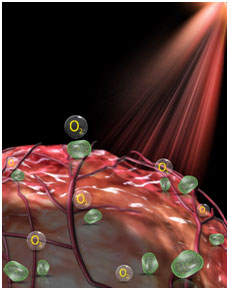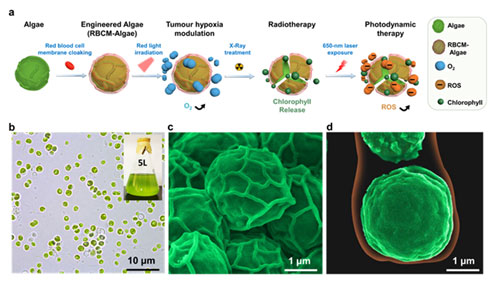Microalgae, a photosynthetic unicellular microorganism in nature, have been extensively used in biofuels, food, and nutrition. Recently, the research team led by ZHOU Min and SUN Yi from the Institute of Translational Medicine and the Second Affiliated Hospital, School of Medicine made groundbreaking discoveries about the role of engineered algae in cancer therapies. Their findings are published in the journal of Science Advances.

In this study, engineered live microalgae can be delivered to hypoxic tumor regions to increase local oxygen levels and resensitize resistant cancer cells to both radio- and phototherapies. The hypoxic environment in tumors is markedly improved by in situ-generated oxygen through microalgae-mediated photosynthesis, thereby boosting radiotherapeutic effects. Furthermore, the chlorophyll from microalgae produces reactive oxygen species during laser irradiation which can further enhance the photosensitizing effect and promoting tumor cell apoptosis. Thus, the sequential combination of the oxygen-generating algae system with radio- and phototherapies has the potential to create an innovative treatment strategy for cancer. These findings demonstrate a novel approach that leverages the products of photosynthesis for treatment of tumors and provide proof-of-concept evidence for future development of algae-enhanced radio- and photodynamic therapies.
Rapidly growing solid tumors inevitably encounter hypoxia due to the outgrowth of the cell mass over vessels. Local hypoxia in tumors is a major impediment to cancer therapies, leading to greatly reduced effectiveness, particularly for radiotherapy (RT) and photodynamic therapy (PDT). Improving oxygenation in hypoxic tumor regions and overcoming hypoxia can substantially enhance the PDT/RT efficacy. Thus, reoxygenation of hypoxic tumors is expected to be an effective approach to overcoming hypoxia-based resistance to conventional cancer therapies.
Researchers have endeavored to adopt the in situ generation of oxygen in tumor with nanocarriers to increase local oxygen in the hypoxic region for enhancement of therapeutic efficacy. However, this approach has very finite translational values, primarily because most of the administered nanocarriers are captured by the mononuclear phagocyte system (MPS) in the liver and the spleen, leading to only 0.7% of the total administered dose being deposited in tumor. High uptake of nanocarriers in major organs increases the risk of systemic toxicity, thereby hindering their clinical application.
ZHOU Min and SUN Yi developed an innovative means so as to overcome tumor hypoxia by in situ generation of O2 using a natural photosynthetic system based on engineered C. vulgaris. They first engineered the red blood cell membrane (RBCM), and used it as an efficient strategy for modification of the algal surface to reduce macrophage uptake and systemic clearance of the algae in order to exploit algal metabolic activity for enhanced delivery of C. vulgaris to tumor tissues. They also demonstrated that the RBCM-engineered algae (abbreviated as RBCM-Algae) successfully delivered to tumor tissues generated O2 in situ under red light-induced photosynthesis to increase tissue oxygenation and alleviate tumor hypoxia, leading to improved RT. The subsequent release of chlorophyll from microalgae by laser irradiation produced ROS to further confer PDT, resulting in further enhanced cancer cell killing.

Characterization of the RBCM-Algae biosystem.(A) Illustrative description of engineered processes and treatments. (B) Photograph of algae (inset, large-scale preparation of algae). Pseudocolor SEM images of algae (C) and RBCM-coated algae (D)
This naturally living biomaterial-based therapy opens up a novel direction for cancer treatment. This study explores the feasibility of clinical translation and offers a new approach to developing tumor therapeutic material, which brings fresh hope to millions of patients.






